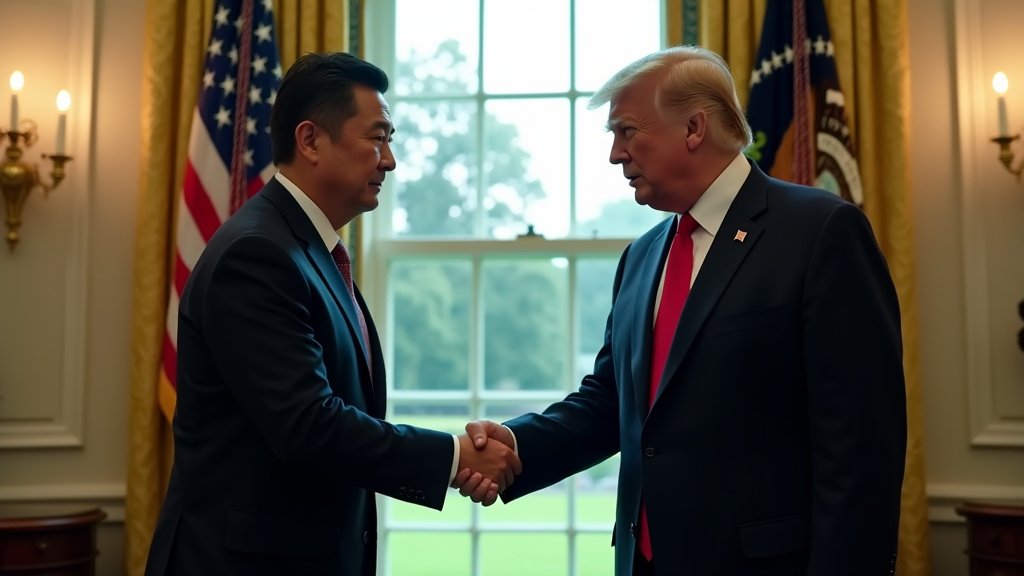In a significant move that is reshaping the geopolitical landscape of the Indo-Pacific, U.S. President Donald Trump has officially approved South Korea’s long-sought plan to develop and build South Korea Nuclear Submarines. The announcement, made via social media on October 29, 2025, after a summit with South Korean President Lee Jae-myung, signifies a major policy shift for Washington and has triggered a complex web of reactions across Asia. This development is a pivotal moment in the ongoing security discussions and represents a trending development in naval power projection, highlighting the growing importance of South Korea Nuclear Submarines.
The U.S. Seal of Approval for South Korea Nuclear Submarines
President Trump declared on his Truth Social platform that the alliance between the United States and South Korea is “stronger than ever before” and, based on this strength, he has granted approval for Seoul to construct nuclear-powered submarines, moving away from their current diesel-electric fleet. This decision fulfills a key ambition for South Korea, which has been seeking the advanced technology for years to bolster its national defense capabilities. Facing escalating threats from North Korea’s nuclear program and China’s growing naval might, South Korea has argued that nuclear propulsion is essential for achieving longer-duration, stealthier patrols and enhanced maritime domain awareness. Unlike conventional submarines, SSNs can remain submerged for extended periods, significantly increasing their operational range and reducing the need to surface for battery recharging, thereby enhancing their ability to track adversaries’ subsea activities. The development of South Korea Nuclear Submarines is a direct response to these regional challenges.
Adding a unique dimension to the deal, President Trump also announced that South Korea would be building its nuclear-powered submarines in Philadelphia shipyards, which were recently acquired by the South Korean conglomerate Hanwha Group. This aspect of the agreement aims to strengthen U.S. shipbuilding capacity and foster industrial reciprocity, aligning with Trump’s “America First, Allies Invest” approach. While the submarines will be conventionally armed, their nuclear propulsion represents a significant technological leap for South Korea Nuclear Submarines, requiring access to nuclear fuel and potentially necessitating revisions to existing U.S.-South Korea nuclear energy agreements that permit only “peaceful use” of nuclear power.
Japanese Media’s Sensitive Reaction to South Korea Nuclear Submarines and Regional Concerns
The news has been met with particular sensitivity by Japanese media outlets, which have offered a range of analyses and expressed notable concerns regarding the development of South Korea Nuclear Submarines. The Yomiuri Shimbun framed the approval as a reward for South Korea’s investment in the U.S. economy, particularly its role in tariff negotiations, while also suggesting it could lead to discussions about revising the bilateral nuclear agreement. The Mainichi Shimbun interpreted the move as an effort by Seoul to reassure its public amidst North Korea’s nuclear advancements and highlighted ongoing consultations with the U.S. regarding nuclear fuel acquisition for these new vessels.
The Sankei Shimbun recalled previous instances where South Korea’s nuclear submarine ambitions were thwarted and noted that the current government secured approval by emphasizing burden-sharing with the U.S. However, it also voiced apprehension that this development could provoke China. Beyond the major newspapers, Japanese netizens on platforms like Yahoo Japan reacted strongly, with many expressing a desire for Japan to also acquire nuclear submarines and urging their own prime minister to engage with President Trump on the matter. This sentiment reflects a broader concern within Japan that South Korea’s enhanced naval capability, particularly its new South Korea Nuclear Submarines, could disrupt regional security balances and potentially accelerate Japan’s own discussions about nuclear propulsion for its submarines.
Geopolitical Ripples and Alliance Dynamics Surrounding South Korea Nuclear Submarines
Beyond Japan, the implications of this decision reverberate across the Indo-Pacific. Beijing has likely interpreted the approval as part of a broader U.S. strategy to contain China through an expanded under-sea alliance network, with South Korea Nuclear Submarines playing a key role. Chinese state media has previously accused the U.S.-South Korea alliance of “nuclear militarization” in Northeast Asia, and Beijing has urged both nations to uphold nuclear non-proliferation obligations. In response to this development, China could potentially increase its submarine patrols and anti-submarine operations in the Yellow and East China Seas.
For North Korea, the U.S. approval provides significant propaganda fodder. Pyongyang is expected to leverage this decision to portray U.S. “nuclear double standards” and further legitimize its own nuclear submarine development programs. The move also extends the logic of the AUKUS pact (Australia, UK, U.S.) into Northeast Asia, potentially creating an informal “AUKUS-plus” network, though it may also raise concerns for Australia regarding AUKUS exclusivity. The project’s timeline suggests the first South Korea Nuclear Submarines might enter service within a decade, well before Australia’s planned fleet acquisition, potentially raising questions about alliance cohesion and precedents within the context of naval power projection.
Future Trajectory and Nuclear Non-Proliferation for South Korea Nuclear Submarines
While the U.S. approval marks a significant breakthrough, legal and diplomatic hurdles remain for South Korea regarding its nuclear submarine program. The revision of the Korea-U.S. nuclear energy agreement will be crucial to secure fuel for the South Korea Nuclear Submarines and will likely involve complex negotiations similar to those undertaken for the AUKUS pact. South Korea has emphasized that its pursuit is for conventionally armed, nuclear-propelled submarines and not for nuclear weapons, aiming to adhere to the Nuclear Non-Proliferation Treaty (NPT).
President Trump’s decision to greenlight South Korea’s nuclear submarine program represents a substantial recalibration of security dynamics in Northeast Asia, with South Korea Nuclear Submarines at the forefront. It signals a deepening of the U.S.-South Korea alliance, a commitment to burden-sharing, and a strategic reorientation within the broader U.S. Indo-Pacific Strategy. However, it simultaneously introduces new complexities, heightened regional tensions, and significant questions regarding nuclear non-proliferation norms, making it a critical development to watch in the coming years concerning the future of South Korea Nuclear Submarines.




